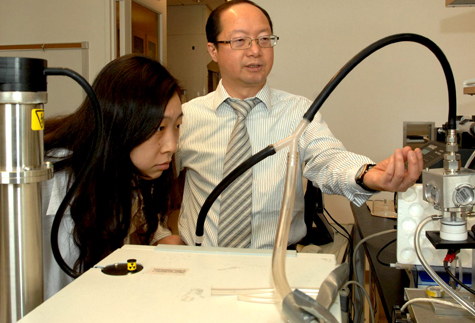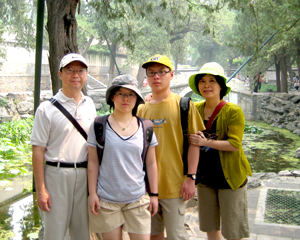
David Kilper
Daren Chen, PhD (right), professor of energy, environmental and chemical engineering (EECE), works with doctoral student Siqin He in a Brauer Hall laboratory. “(Chen’s) expertise in aerosol instrumentation is noteworthy, and his innovations have led to commercialization of instruments that are used to measure nanoparticles in laboratories across the globe,” says Pratim Biswas, PhD, the Stifel and Quinette Jens Professor of Environmental Engineering Science and EECE department chair.
Daren Chen, PhD, tells good stories.
A native of Taiwan, where snow is rare, Chen, professor of energy, environmental and chemical engineering (EECE) and director of graduate studies in EECE, related the adventure of his first major snowfall as a doctoral student at the University of Minnesota in 1991.
He and his wife, Leelee, excitedly went out and played like children, noting the pretty crystals, building their first snowman, and watching from their third-floor apartment as the yellow lights of Minneapolis struggled against the blinding whiteness of a storm that dumped 24 inches on the community in one day.
The next morning, he dutifully went to a bus stop to go to campus. He waited in vain for 40 minutes before returning to his apartment to issue a phoned-in complaint to the bus company.
“The lady was very nice and explained that they had shut the whole bus system down and there was no school that day,” Chen says in his Brauer Hall office. “Now, it was actually near Halloween, and I wondered if the university would be closed for most of the winter. How would I get my doctoral work done in time?
“I stayed at Minnesota for nearly 10 years, and that was the only time the university shut down,” Chen says. “I thought all of the winters would be like that.”
A better tale yet is how Chen came to Minnesota in the first place and how he became a particles engineer.
More than the spray can
Chen had applied to graduate schools across the United States in 1990-91 and was accepted universally but, in recessionary times, no school could offer him financial aid. He accepted entrance into Minnesota because tuition was cheaper at the state school and he could finance his first year on his own.
Possessing master’s degrees in two different disciplines at the time, with a wealth of experience and more than 10 publications already under his belt, Chen figured somebody must be able to use his services as a student in his or her lab. In August of 1991, he visited Minnesota and made the rounds, resume in hand, of more than 12 engineering professors, coming up empty each time.
“Then I came upon this professor walking in the hallway,” he says. “I noticed the professor carried a brochure about National Tsing Hua University, where he had been invited to give a talk, and I told him that was my university. He was interested in knowing the university in the first place and offered to talk with me.”
The professor was David Pui, PhD, and, in his office, Pui realized Chen was looking for an adviser for the doctoral study. He told Chen that he was doing aerosol and particles research. Impressed with Chen’s background and publication, Pui asked Chen to become his student.
Envisioning cans of deodorant and room refresher, Chen wondered how a discipline had emerged just based on a spray can design.
“It’s almost embarrassing to admit that aerosols at the time meant the spray can to me,” he says, smiling. “I asked him for some background and he smiled at me and produced this encyclopedia article he had written on aerosols research. I read it eagerly.”
He soon learned that aerosols in Pui’s context were systems of particles with various sizes and compositions, suspended in air or other gaseous environments. Generated naturally or man-made, aerosols are wide-ranging and can be deleterious to health but have beneficial uses as well.
“I thought that now I can integrate all of my learning and apply it to an additional area,” Chen says. “I happily took his offer. Dr. Pui changed my interpretation of aerosols and gave me a new direction, all by chance.”
Over the next 10 years at the University of Minnesota, Chen filed more than 10 patents, and worked on numerous projects related to aerosol generation/synthesis, instrumentation, characterization, processing and control, most with industrial applications. Some aerosol instruments he had worked on now are commercially available and widely used by the aerosol research community.
Innovative work
Chen came to Washington University in 2001. Via introduction by Ruth Chen, PhD, of EECE, Chen began collaboration in 2007 with Ming You, MD, PhD, formerly of the School of Medicine (currently director of the Medical College of Wisconsin Cancer Center). The collaboration continues to this day on an aerosol administration of potent agents aimed at preventing lung cancer tumor growth.

Courtesy photo
The Chen family at the Summer Palace in Beijing (from left): Daren; daughter, Amelia; son, Nathaniel; and wife, Leelee.
“We study how to make particles of desired sizes from potential chemoprevention agents and encapsulate them along with biodegradable polymers in some cases,” Chen says. “By targeting only the lung with aerosols, we want to bypass side effects that are likely to occur via ingestion or injections, which distribute the drug throughout the body.”
“Daren Chen is an active member of the world-renowned Aerosol Group, consisting of six faculty members, at Washington University in St. Louis and a key EECE faculty member,” says Pratim Biswas, PhD, the Stifel and Quinette Jens Professor of Environmental Engineering Science and EECE department chair. “His expertise in aerosol instrumentation is noteworthy, and his innovations have led to commercialization of instruments that are used to measure nanoparticles in laboratories across the globe.
“A current innovation is the miniaturization of a size distribution measurement instrument that will allow us to widely deploy and monitor exposure to airborne nanoparticles,” Biswas says. “His innovative work is enabling research in many fields.”
Chen also studied how to load drugs on stents — small mesh tubes that are used to treat narrowed or weakened arteries in the body — for cardiac patients; the drugs inhibit tissue from growing over the stent, necessitating surgery a year or two later to replace the stents. The drug-loaded stent also shows promise to deliver a therapy that can repair the artery itself. A company has licensed this technology.
A new thrust that excites Chen is the miniaturization of individual particle sensors. Epidemiological studies of humans’ exposure to air pollutants, Chen says, rely on inaccurate local air quality data usually averaged over time and space to give an estimate of individual exposure. Current studies often neglect such things as a person’s mobility or locale.
Chen envisions making sensors small enough for an individual to carry and thus track and record the person’s daily and hourly exposure over a wide space, ultimately improving data for epidemiology studies.
Collaborating with researchers in NASA, Chen also has used the miniature particle size that he had developed as a part of a special smoke detector that was tested by the National Institute of Standards and Testing on more than 200 different kinds of fires and found to be 100 percent accurate.
This sensor measures both the concentration of gases and particles in a room as well as size distribution, which provides a fire fingerprint that distinguishes between a real fire and Uncle Harry’s smelly cigar, for instance.
“I’m very interested in making this better sensor cheap enough to eventually allow networks in large buildings and ultimately save human lives,” Chen says.
Fast facts about Daren Chen
Classes: He regularly teaches “Transport Phenomena II” (ChE 368) to undergraduate students and advanced aerosol and nanotechnology classes to graduate students (ChE 563, 592A and 526). He used to teach fluid mechanics (ME 370), “Transport Phenomena” (Env 583), Nanotechnology classes (ME 163, 263), “Propulsion” (ME 488A) and “Heat Conduction and Convection” (ME 530).
Recent award: He received the Big Fish Award from the Association of Graduate Engineering Students in 2009 for the best graduate teacher and mentor of students.
Family: Wife, Leelee, works in the home, and children Amelia, 17, and Nathaniel, 15, attend Parkway North High School. Amelia has been admitted to WUSTL in Fall 2011.
Hobbies: Fishing and playing tennis